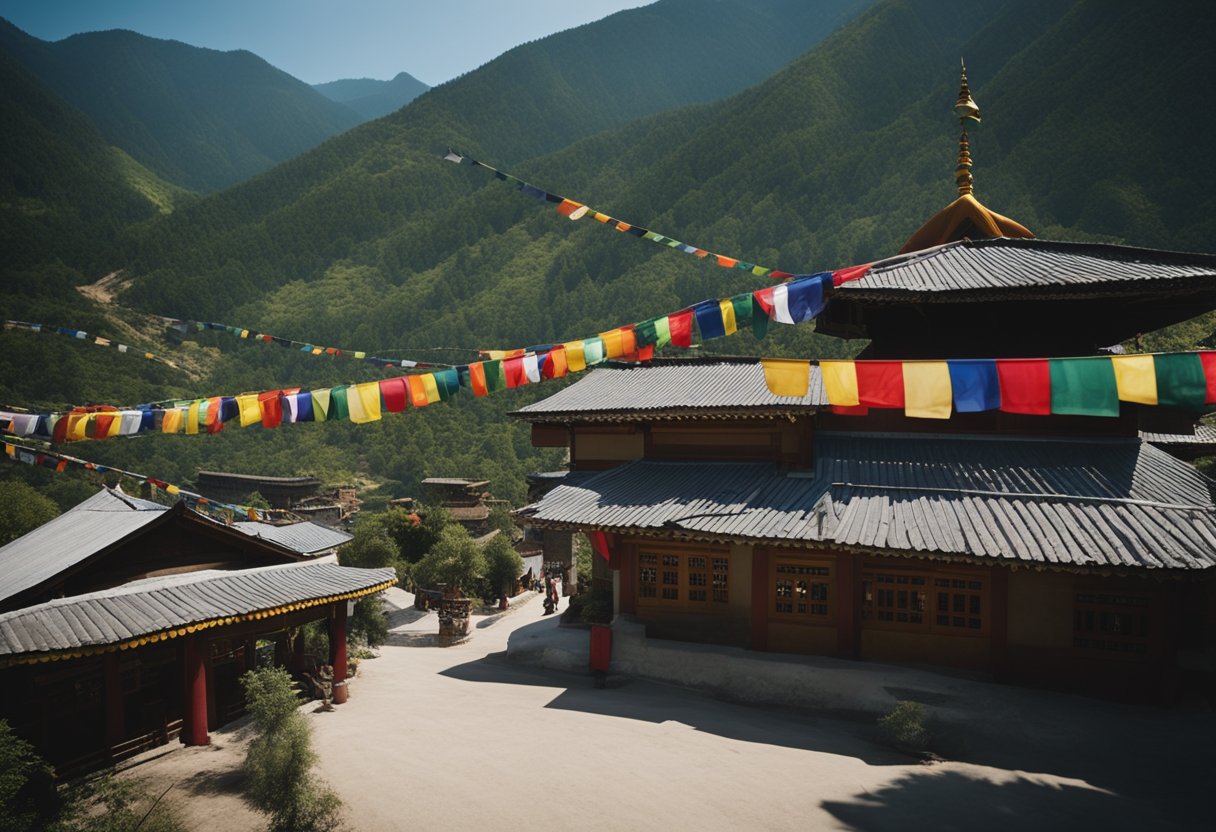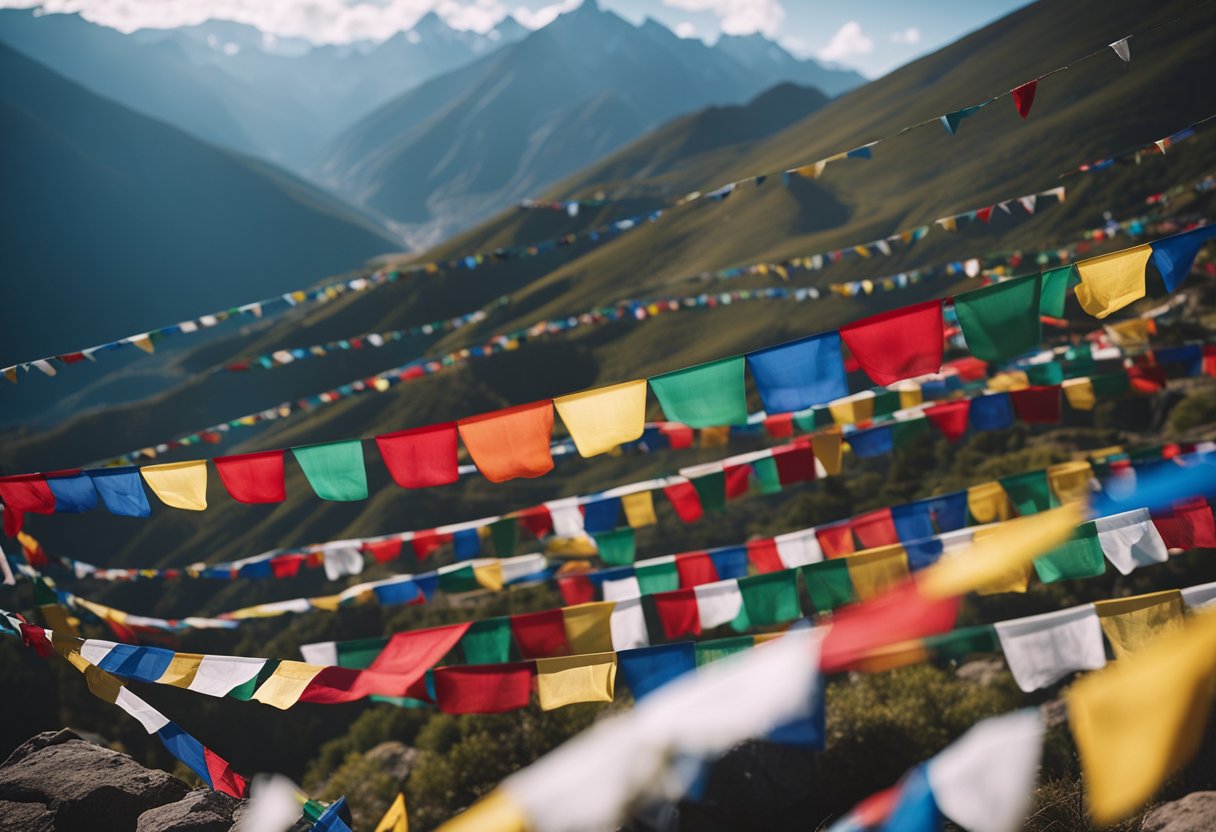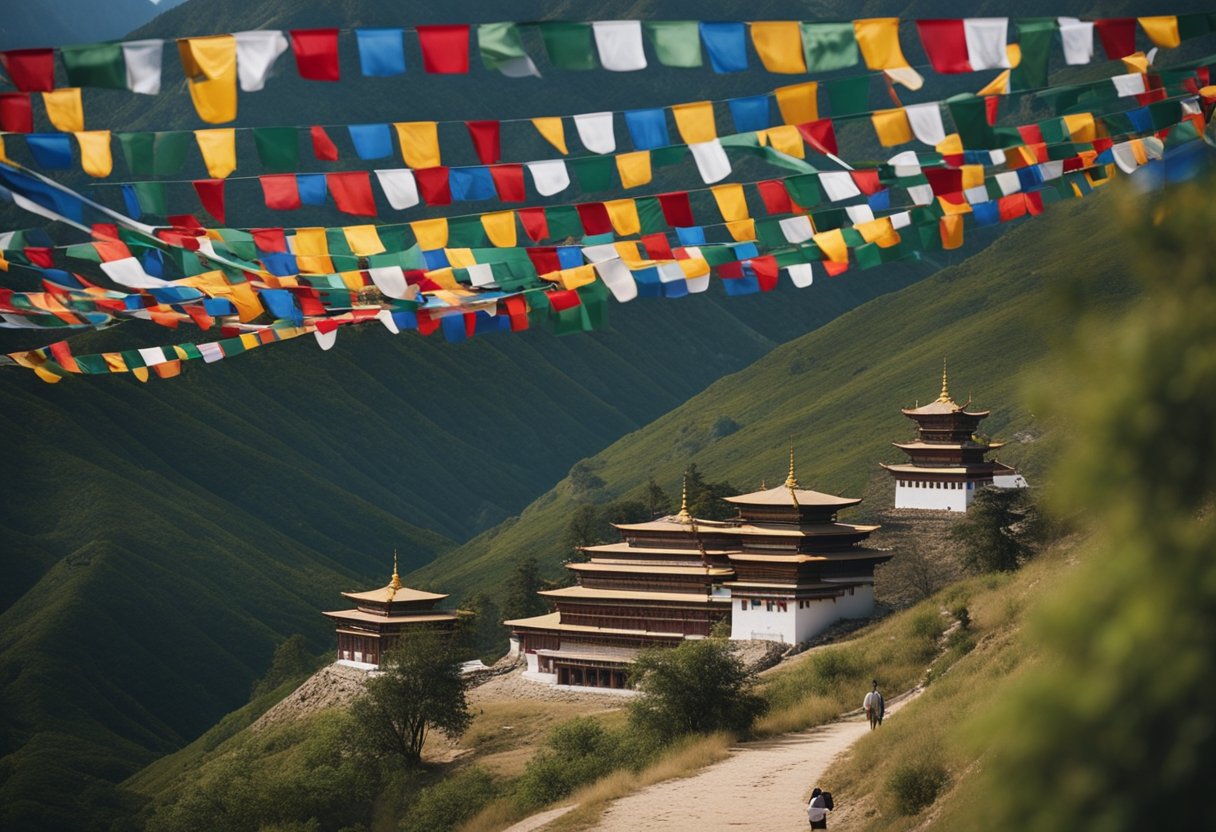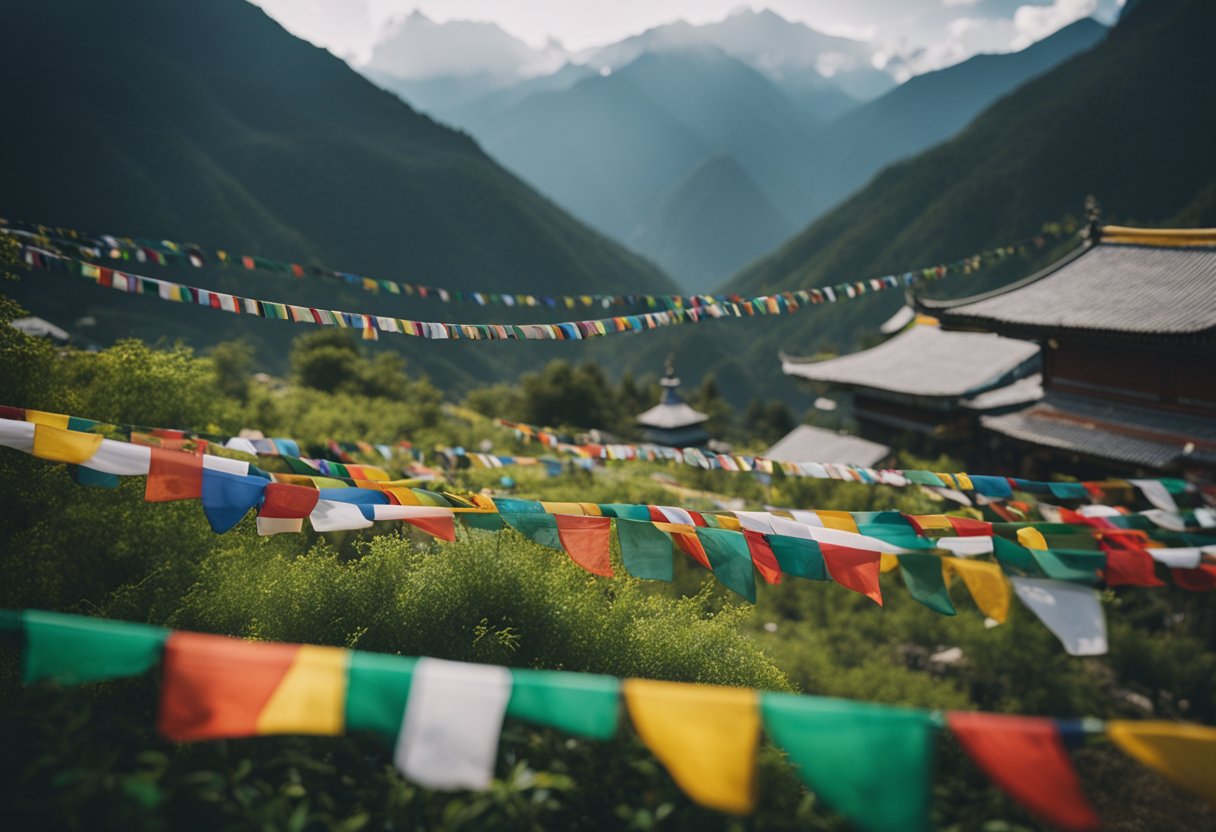Tibetan Buddhism: Spiritual Practices in the Himalayas Explored
Updated On: April 23, 2024 by Marwa Alaa
Tibetan Buddhism reflects an immense landscape of spiritual practice and philosophical richness intertwined with the history of the Himalayas. As a form of Buddhism that took root in Tibet, it has significant followings across the Himalayan region, including in nations such as Bhutan and Nepal, as well as areas of India like Sikkim and Ladakh. This spiritual tradition encapsulates many meditation techniques, rituals and festivals that foster compassion and aid practitioners on their path to enlightenment. With a history of the 7th century CE, Tibetan Buddhism is not just a religion or philosophy but a way of life profoundly connected with the culture and peoples of the Himalayas.
The core elements of Tibetan Buddhism are grounded in Vajrayana, also known as Tantric Buddhism, which includes a diverse set of esoteric practices aimed at accelerating the path to awakening. These practices are complemented by disciplined philosophical studies in the form of Madhyamika and Yogachara teachings, which provide the intellectual underpinnings of the tradition. Integral to its belief system are the sacred texts written in the Tibetan language, which capture the teachings of Buddha and the commentaries of esteemed practitioners. Beyond the pages of these texts, one finds a vibrant artistic expression through iconography and sacred art, a reflection of Vajrayana’s inner processes and spiritual ideals.
Historical Context of Tibetan Buddhism

Tibetan Buddhism has an intricate history that spans centuries and has been shaped by various influences and expansions throughout the Himalayas.
Origins and Early Development
The roots of Tibetan Buddhism can be traced back to the 7th century when Buddhism began filtering into Tibet from India and Central Asia. It is often considered that a seminal moment occurred during the reign of King Thothori Nyantsen when a basket of Buddhist scriptures arrived from India, profoundly influencing the indigenous Bon religion.
The Influence of Padmasambhava
Padmasambhava, also known as Guru Rinpoche, played a pivotal role in Tibetan Buddhism’s history. Around the 8th century, he was invited by King Trisong Detsen of Tibet to help establish Buddhism in the region. His methods and teachings, particularly those associated with the Nyingma tradition—the oldest of the four main schools—were instrumental in laying the foundations of Tibetan Buddhism.
Buddhism’s Spread Through the Himalayas
As Tibetan Buddhism evolved, it spread across the Himalayan region into countries such as Bhutan, Nepal, and Mongolia, aided by translating numerous Buddhist texts into Sanskrit and other local languages. Monastic institutions flourished, and the subsequent establishment of schools, including Kagyu, Sakya, and Gelug, furthered the reach and depth of Buddhism in Tibet. The latter school is presided over by the Dalai Lama, representing a significant figure for both the Tibetan diaspora and the religion itself.
In these ways, Tibetan Buddhism became deeply woven into the fabric of Himalayan society, continuing to influence countless lives through its spiritual practices and philosophies.
Core Philosophies and Doctrines
In the profound spiritual landscape of Tibetan Buddhism, certain philosophies and doctrines form the cornerstone of its practice, which aims at achieving enlightenment through compassion and understanding of the nature of reality.
The Four Noble Truths
The Four Noble Truths are the bedrock of Buddhist teaching. First, suffering (dukkha) is an intrinsic part of existence. The second truth is the origin (samudaya) of suffering, which lies in desire and attachment. The third noble truth is the cessation (nirodha) of suffering, a state that can be achieved through detachment. Finally, there is the path (magga) leading to the cessation of suffering, detailed in the Eightfold Path. Tibetan Buddhism incorporates these truths with a focus on the Vajrayana tradition, which is considered a quicker, yet more challenging, route to enlightenment.
Karma and Reincarnation
In our teachings, karma is a fundamental doctrine signifying action or deed. It emphasises that the moral quality of our actions determines our future. Good actions lead to positive outcomes, while negative actions lead to suffering. Choosing actions with mindful compassion shapes a favourable rebirth—a cycle known as samsara. Reincarnation is the transmigration of the soul (‘lu’) based on karmic imprints (‘dre’), with the ultimate goal being liberation from this cycle.
The Schools of Tibetan Buddhism
Tibetan Buddhism is divided into several schools with distinct philosophies and practices. The Nyingma is the oldest, dating back to the 8th century, and emphasises the practices of Dzogchen for achieving enlightenment. The Kagyu school focuses on the continuity of oral teachings and meditation, for example, the Six Dharmas of Naropa. The Sakya school proposes a synthesis of scholarly study and meditative discipline. Lastly, the Gelug, founded in the 15th century by Je Tsongkhapa, places great emphasis on monastic discipline and scholarly learning, with a strong connection to Buddhist monasteries.
In these schools, the pursuit of wisdom is coupled with compassion towards all sentient beings to alleviate suffering and attain enlightenment. Our understanding and practices of these doctrines are the essence that makes Tibetan Buddhism a unique and transformative path within the wider spectrum of Buddhist religion and teachings.
Sacred Texts and Language

As we explore Tibetan Buddhism, it’s crucial to understand the languages and texts that form the bedrock of its spiritual heritage. These scriptures encompass profound spiritual knowledge and reflect the linguistic journey from sacred Sanskrit origins to the Tibetan interpretations central to the practice within the Himalayas.
The Significance of Sanskrit
Sanskrit plays a foundational role in the fabric of Tibetan Buddhism. It is the original language of many Buddhist texts, and its influence extends beyond mere communication—it serves as a vessel for preserving the authenticity and purity of the teachings. The profound texts of Buddhism, originally penned in Sanskrit, are revered for their linguistic intricacy and spiritual depth. Indeed, many chants and mantras still resonate in their original Sanskrit form within the walls of monasteries, retaining the vibrational quality that practitioners believe links them to the essence of the dharma.
Tibetan Scriptures and Commentaries
In our journey into Tibetan spiritual literature, we encounter many Tibetan scriptures. These include the Kangyur, the words of the Buddha, and the Tengyur, commentaries by esteemed scholars. Monasteries across the Himalayas invest considerable resources in the preservation and study of these precious texts, which are often written in the Tibetan script derived from classical Sanskrit.
The process of studying these texts is integral to monastic education, where monks meticulously analyse and debate the scriptures and their commentaries. Moreover, the discovery of hidden scriptures, known as terma, continues to add to the dynamic evolution of Tibetan Buddhism. Combined with prophecies and teachings, these terms offer a unique lens through which to view the religion’s adaptability and the importance placed on revelation and spiritual treasure in the Himalayan region.
Engaging with these texts, whether written in Sanskrit or Tibetan, invites us into an expansive world of thought, where language serves as both a medium for teaching and a spiritual practice.
Rituals and Practices
In Tibetan Buddhism, rituals and practices are integral to spiritual development, providing structured pathways to cultivate compassion and wisdom.
Daily Practices of Devotion
We begin our days with prostrations and the recitation of mantras, specific phrases designed to purify the mind and awaken our latent spiritual qualities. It’s common to use a mala—a string of beads—to keep count while reciting mantras. Engaging in these practices, we set a compassionate intention for our actions throughout the day.
Meditation Techniques and Retreats
Meditation is central to our practice. We utilise various techniques, from calm abiding to promote mental stability to analytical meditations that delve into teachings such as impermanence. Vajrayana meditation often requires initiation from a qualified teacher. We may also partake in retreats—periods of intensive practice away from daily distractions, allowing us to deepen our experience.
Ritual Objects and Symbols
Ritual objects embody and remind us of various aspects of the spiritual path. The vajra, a symbolic ritual implement, embodies the indestructible nature of reality and compassion. Similarly, a bell represents wisdom and is often used alongside the vajra in tantric practices. Thangka paintings and statues serve as focal points for meditation and embodiments of enlightened energy. We carefully utilise these objects and symbols within the ritual context to support and enhance our practice.
Sacred Arts and Iconography
In the spiritual tapestry of Tibetan Buddhism, the sacred arts and iconography hold significant weight in encapsulating the religion’s core tenets. In this context, Iconography refers to the use of symbolic images and figures to convey spiritual truths and practices.
Firstly, our focus turns to the intricate arts that narrate the tales of the faith’s pantheon. Thangkas, vibrant paintings on cotton or silk, serve as mediational tools for novices and tantric adepts alike. Murals and sculptures found in monasteries also stand as testimony to this rich artistic heritage.
Vajrayana Buddhism, steeped in complexity, employs these visual narratives in many ways. Mandalas, for instance, are geometric representations of the universe, meticulously crafted to guide practitioners through the cosmic symbolism during rituals and education. These sacred diagrams are not merely ornamental; they function as a microcosm of the practitioner’s spiritual journey.
The pantheon, an assembly of deities and figures, is vividly portrayed in all forms of Tibetan Buddhist art. Each god, goddess, and Bodhisattva is depicted with unique attributes, hand gestures (mudras), and implements, reflecting their qualities and defining their role within the spiritual hierarchy.
Lastly, the Vajrayana tradition is renowned for using ritual objects such as vajras (thunderbolts), bells, and drums. These are symbolic and integral to the practice of tantra, emphasising the sensory experience as a path to enlightenment.
By engaging with these artistic and iconographic elements, we deepen our understanding of the profound symbology embedded within Tibetan Buddhism. Through appreciation and study, we preserve these practices and enrich our global cultural heritage.
Monastic Life and Education
In the solitude of the Himalayas, Tibetan monastic life and education stand out as the bedrock of spiritual practice, cultivating the minds and spirits of those who pursue the Buddhist way of life.
Tibetan Monastic Institutions
Tibetan Buddhist monasteries serve as sanctuaries of learning and spiritual practice. These institutions, such as those following the Gelug tradition, are deeply rooted in studying Buddhist scriptures and mastering debate. Monks and lamas engage in rigorous intellectual training that spans over decades, covering a vast array of subjects from philosophy to metaphysics. Tulkus, or reincarnate lamas, often receive their education within these sacred walls, continuing their predecessor’s legacy. The monasteries not only offer religious education but also serve as a community hub for the lay population, providing various services and spiritual guidance.
- Key Areas of Study:
- Philosophy and Ethics
- Metaphysics
- Logic and Debate
- Rituals and Tantric Practices
The Role of the Sangha
The Sangha, the Buddhist community of monks, nuns, and novices, plays a crucial role in maintaining and disseminating the teachings. United by their monastic vows and dedication to the Dharma, the Sangha embodies the living tradition of Buddhist monasteries. They are responsible for preserving ancient texts, performing religious ceremonies, and providing spiritual mentorship. In the diaspora caused by political turmoil, the Sangha has been pivotal in spreading Tibetan Buddhism across the globe, establishing monasteries and teaching centres in diverse locations.
- Responsibilities of the Sangha:
- Preservation of texts
- Spiritual mentorship
- Performance of ceremonies
- Spreading Dharma teachings globally
Spiritual Leaders and Hierarchy
In Tibetan Buddhism, the spiritual hierarchy is defined predominately through two key components: the esteemed position of the Dalai Lama and the unique reincarnation system for identifying lamas, known as the Tulku system.
The Role of the Dalai Lama
The Dalai Lama is a spiritual and historical leader in Tibetan Buddhism. He is often seen as the embodiment of compassion and is responsible for teaching and upholding Buddhist practices and beliefs. Historically, the Dalai Lamas have also held political power in Tibet, although the current, 14th Dalai Lama has devolved these responsibilities to democratic institutions. The Dalai Lama, belonging to the Gelug school, is the most recognised face of Tibetan Buddhism, with a reach and influence that extends far beyond the Himalayas.
The Tulku System and Reincarnated Lamas
The Tulku system is a form of succession where the consciousness of a deceased lama is believed to be reborn. It is a process steeped in rich tradition and involves the discovery and education of these reincarnated lamas, who are often found at a young age and then groomed for their future roles. This system is not unique to one school but is a practice observed across various sects, including the Nyingma, Kagyu, Sakya, and even the pre-Buddhist tradition of Bon. Moreover, within the Nyingma tradition, figures like Guru Rinpoche and tertöns, revealers of hidden teachings, also hold significant spiritual authority.
Folk Traditions and Local Beliefs

In the rich tapestry of Tibetan Buddhism, the spiritual topography of the Himalayas is densely woven with folk traditions and local beliefs that predate Buddhism itself. These practices have been integrated into the Buddhist framework, creating a unique syncretic form of spirituality.
Incorporation of Bon Practices
Bon, the indigenous religion of Tibet, has significantly influenced Tibetan Buddhism. Bon’s pantheon of deities and emphasis on the connection with nature is still evident in local spiritual practices. Our spiritual rituals often involve subjugating local spirits and protectors integrated into the Buddhist belief system as protectors or wrathful deities. The incorporation demonstrates how Tibetan Buddhism has assimilated pre-existing beliefs to form an adapted religious identity that deeply respects the natural and spiritual heritage of the region.
Deities and Local Gods
Deities and local gods play a pivotal role in the daily lives of Himalayan peoples. Mamo, tsen, and nyen are among the many spirits affiliated with elements like rain, earth, and the well-being of children. These spiritual entities are revered and appeased through various rituals to maintain harmony with their governing elements. In our localities, sangha community members, who embody Buddhist communal values, often lead these practices, ensuring the coexistence of Bon and Buddhist traditions.
Modern Tibetan Buddhism

Tibetan Buddhism has faced a transformation in modern times, particularly in response to geopolitical shifts in the 20th century. The diaspora has spread Tibetan spiritual practices worldwide, moving beyond the Himalayan region to global communities.
Tibetan Buddhism in Exile
Following the 1959 uprising in Tibet, many Tibetans, including the Dalai Lama, fled to India and other parts of the world, creating a significant diaspora. Settling primarily in India, Nepal, and Bhutan, these expatriates established monasteries and schools to preserve their religious and cultural heritage. In India, towns such as Dharamshala have become centres for Tibetan culture and spirituality, attracting people from all corners of the globe seeking to study and experience Tibetan Buddhism.
The Global Spread of Vajrayana Buddhism
The diffusion of Tibetan spiritual practices has not been confined to the regions surrounding Tibet. In the West, the teachings of Tibetan Buddhism have been embraced by numerous individuals seeking alternative spiritual pathways. This has been facilitated through translating texts and the work of Tibetan teachers touring Western countries. Additionally, countries like Mongolia, Russia, and its regions of Tuva and Buryatia have seen a revival of Tibetan Buddhism after decades of religious suppression. Moreover, exchanges with other Buddhist traditions in Japan and engagement with Chinese followers within China have contributed to the formation of an intricate tapestry of Vajrayana practice worldwide.
Buddhism and Contemporary Issues
In this section, we discuss how Tibetan Buddhism navigates the complexities of modern-day life, from its engagement with political structures to its contributions to personal health and societal well-being.
Interactions with Politics and Society
Tibetan Buddhism holds a significant position within the socio-political tapestry of the Himalayan regions and beyond. State policies often influence religious practices and the visibility of Tibetan Buddhist values in public life. The religion’s interaction with politics can be illustrated in the role that spiritual leaders, such as the Dalai Lama, play in advocating for peace and human rights internationally. Ever mindful of the delicate balance between Buddhism and governance, these leaders must navigate the intricacies of both preserving their religious heritage and engaging with contemporary societal issues.
Within society, Tibetan Buddhism extends its influence through various social programs and initiatives aimed at communal development, further intertwining the threads of religion and community welfare. Deeply ingrained values, like compassion and altruism, drive efforts to improve social justice and ethical governance, reinforcing the integral relationship between Buddhism and its societal context.
Health and Well-being in Buddhist Practice
The influence of Tibetan Buddhism on health and well-being is considerable, permeating both individual practices and the broader healthcare narrative in societies where the religion is practised. Tibetan Buddhist meditation techniques and mindfulness practices are known to positively impact mental health, often employed to reduce stress, enhance focus, and foster emotional balance.
Physical health, too, is positively affected by Buddhist teachings that encourage healthy living and care for the body as a vessel for spiritual development. In the context of health, practitioners find support in communities and guidance in ancient texts that outline medical knowledge, intertwining Tibetan Buddhism’s traditions with contemporary healthcare practices. The holistic approach taken by Tibetan Buddhism offers a unique perspective, viewing well-being through a lens that integrates the body, mind, and spirit.
Ceremonies and Festivals
Tibetan Buddhism is adorned with various ceremonies and festivals embody the Himalayas’ spiritual vibrancy. These events are integral to the Buddhist tradition, fostering a profound sense of community and spirituality.
Festivals such as the Monlam Prayer Festival provide collective prayer and merit-making opportunities. They often manifest with splendid music, dance, and art exhibitions, bringing together laypeople and monastics in harmonious celebration.
Their cognitive effects on the participants heighten our understanding of these ceremonies. Engaging in liturgies and the veneration of sacred objects often leads to heightened awareness and mental clarity. The shared experience supports collective cognition, enhancing individual and group understanding of the dharma.
The festivals usually follow the lunar calendar, each carrying its own rituals and customs. For example, during the Saga Dawa festival, marking the anniversary of Buddha’s birth, enlightenment, and parinirvana, adherents engage in acts of kindness and pilgrimage, reaffirming their commitment to the path of enlightenment.
| Festival Name | Activity |
|---|---|
| Monlam | Prayer and teachings |
| Losar | New Year celebrations |
| Saga Dawa | Pilgrimage and charity |
In dialogue, these festivals often discuss their role in preserving Tibetan Buddhist tradition amidst the modern world, showcasing the enduring importance of these ceremonies to the people of the Himalayas and the global Buddhist community.
We also observe the intricate rituals that form the tapestry of Himalayan faith. Mandalas, prayer flags, and butter lamps are commonplace, each serving to honour and broadcast prayers across the spiritual and physical realms, reflecting a vibrant religious culture steeped in meaning and intention.
FAQs
Within the vast expanse of the Himalayas lies a deep-rooted spiritual tradition known as Tibetan Buddhism. Our section aims to shed light on the core aspects of this profound practice through a series of frequently asked questions.
What are the three main tenets of Tibetan Buddhism?
Tibetan Buddhism upholds three principal commitments: the development of wisdom, the cultivation of compassion, and the aspiration to achieve enlightenment for the benefit of all beings. These tenets are foundational to the Mahayana tradition and are deeply embedded in the spiritual practices within the Himalayan regions.
How do the practices of Tibetan Buddhism differ from other forms of Buddhism?
Its incorporation of the Vajrayana path distinguishes Tibetan Buddhism, its extensive use of ritual and symbolic activities, and the lama’s or spiritual teacher’s significant role. While Theravada Buddhism focuses on monastic life and meditation as a means to achieve Nirvana, Tibetan Buddhism includes a variety of ceremonial practices and the veneration of bodhisattvas.
What roles do rituals play in the Tibetan Buddhist tradition?
Rituals in Tibetan Buddhism are integral to the spiritual practice. They are designed to appease deities, honour spiritual masters, and accumulate merits. Through rituals, practitioners seek to cultivate spiritual energy, invoke blessings, and reinforce their connection to the Dharma. Learn more about the central function of ritual traditions in Tibetan Buddhism.
Could you describe the four main schools within Tibetan Buddhism?
The four primary schools of Tibetan Buddhism are the Nyingma, Kagyu, Sakya, and Gelug. The Nyingma school is the oldest tradition, known for emphasising Dzogchen. The Kagyu tradition specialises in the practice of Mahamudra. The Sakya sect is known for its scholarly approach and tantric practices. Finally, the Gelug school, founded by Tsongkhapa, prioritises monastic discipline and scholarly study.
What is the role of a Tibetan Buddhist monk, and what are they typically called?
A Tibetan Buddhist monk, commonly called a bhikkhu or lama, serves as a spiritual guide and teacher. They engage in meditation, study, and teaching while upholding a life of celibacy and poverty. Monks in the Tibetan tradition are also often involved in various rituals and ceremonial functions.
For those new to the subject, what constitutes the essence of Tibetan Buddhist spirituality?
The essence of Tibetan Buddhist spirituality centres on the transformation of the mind and heart. It combines deep philosophical inquiry with practical meditation techniques, aiming to cultivate wisdom, compassion, and a recognition of the interdependent nature of reality. Engaging in spiritual practices such as mantra recitation, meditation, and visualisation helps practitioners align with these core principles.






